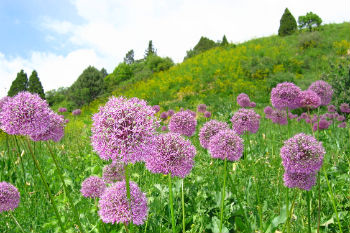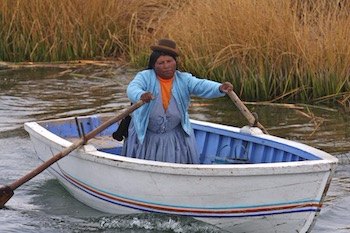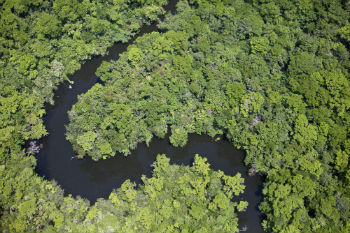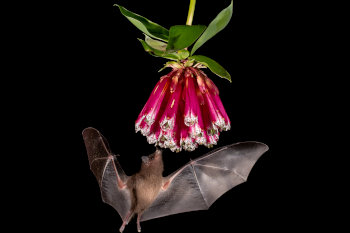Impressive plant endemism in Southwest Australia is attributed to millions of years of isolation from the rest of Australia by the country's vast central deserts. Extreme climate shifts and poor soils also promoted specialization of the region's flora.
Plants
More than half of the 5,570 species of the hotspot's vascular plants are found nowhere else. Four families are endemic: Ecdeiocoleaceae, Emblingiaceae, Eremosynaceae and the monotypic Cephalotaceae, which is represented by the pitcher plant (Cephalotus follicularis), a carnivorous plant listed as Vulnerable on the IUCN Red List of Threatened Species.
The Banksia plants of the family Proteaceae are among the most distinctive found in this hotspot. These brilliant flowering plants range from trees to small prostrate plants, one of which even has underground stems. Kangaroo paws (Anigozanthos spp.) are another brightly colored flower from the region; their long stems are thought to resemble their namesakes.
The region's flagship tree species include three eucalyptus: jarrah (Eucalyptus marginata), marri (E. calophylla) and karri (E. diversicolor). While jarrah and marri grow to only about 20-30 meters in height, some karri forests have canopies up to 70 meters high, and individual trees may grow as high as 80 meters, ranking this endemic species as one of the tallest trees on Earth.
Birds
Over 280 native bird species occur in the region, 12 of which are endemic. The level of endemism is slightly higher than in other Mediterranean-type hotspots.
The region is home to 22 parrot species (three endemics), including the Endangered Carnaby's black-cockatoo (Zanda latirostris). The Endangered noisy scrub-bird (Atrichornis clamosus), which earned its name because of the loud vocalizations of its males, was presumed extinct until a small population was rediscovered in 1961. Several other bird species are near threatened or rapidly declining in the face of habitat loss, modification and fragmentation or inappropriate fire regimes.
Mammals
This hotspot has roughly 60 native mammal species occurring, of which 12 are endemic, including the mouse-sized, nectarivorous honey possum (Tarsipes rostratus), the only representative of the family Tarsipedidae, which lives only in the coastal plain heaths of Southwest Australia. Another interesting endemic is the Vunlerable quokka (Setonix brachyurus), a small, furry wallaby.
Some mammal species have become de facto endemics to Southwest Australia because they are extinct in the rest of their natural ranges. The numbat (Myrmecobius fasciatus, VU), for example, a squirrel-sized marsupial anteater, is the only member of the family Myrmecobiidae, and has become the mammalian symbol of Western Australia. Besides the numbat, four other threatened mammals are endemic to the hotspot, including the most threatened species in the hotspot, the Critically Endangered Gilbert’s potoroo (Potorous gilbertii), which today occurs only in Two People's Bay Nature Reserve.
Reptiles
As might be expected in a country that leads the world in reptile diversity, there are a wide variety of reptile species in Southwest Australia. Nearly 30 of more than 175 species are endemic to the hotspot, including the Critically Endangered western swamp turtle (Pseudemydura umbrina), the most threatened reptile in Australia.
Other threatened reptiles include the Vulnerable Yinnietharra rock dragon (Ctenophorus yinnietharra), an understudied lizard species that is apparently specialized to two granitic rock outcrops in the region and does not inhabit outcrops of different origins, and the Vulnerable Lake Cronin snake (Paroplocephalusatriceps) whose very limited range includes unprotected private lands.
Amphibians
There are more than 30 species of amphibian found in this hotspot, nearly two-thirds of which are endemic, including four species that represent endemic genera: the turtle frog (Myobatrachus gouldii), Nicholl's toadlet (Metacrinia nichollsi), Sandhill frog (Arenophryne rotunda), and Vulnerable harlequin frog (Spicospina flammocaerulea).
Freshwater fishes
The Southwest Australia Hotspot has very little freshwater habitat and thus only about 20 native species of freshwater fish. However, about half of these species and three genera are endemic, the most remarkable being the salamanderfish (Lepidogalaxias salamandroides), which is the only member of the hotspot's single endemic family (Lepidogalaxiidae).




